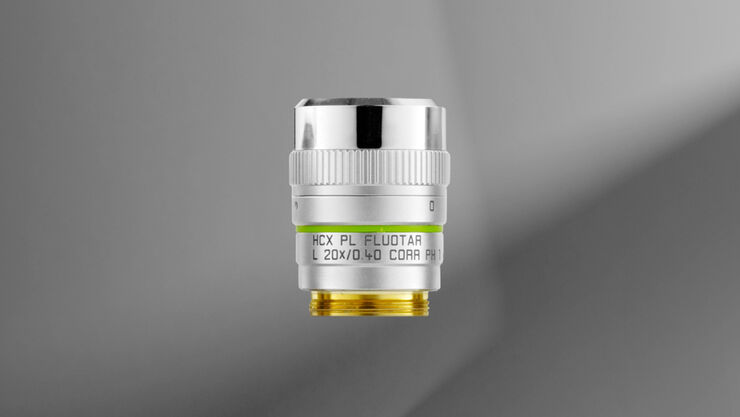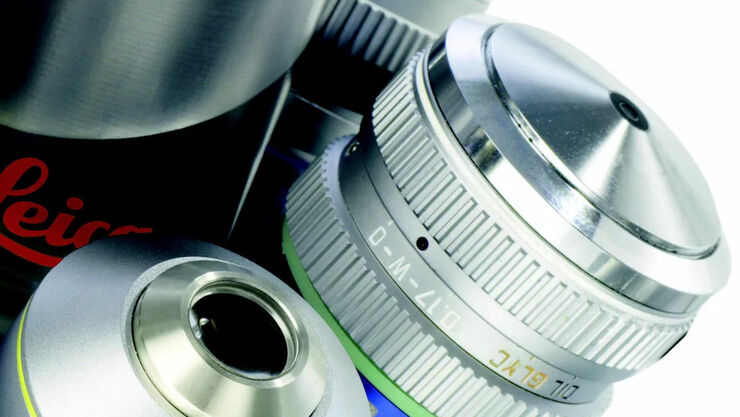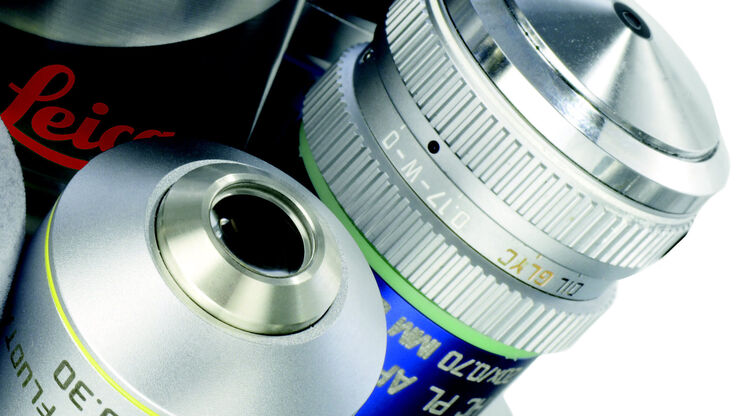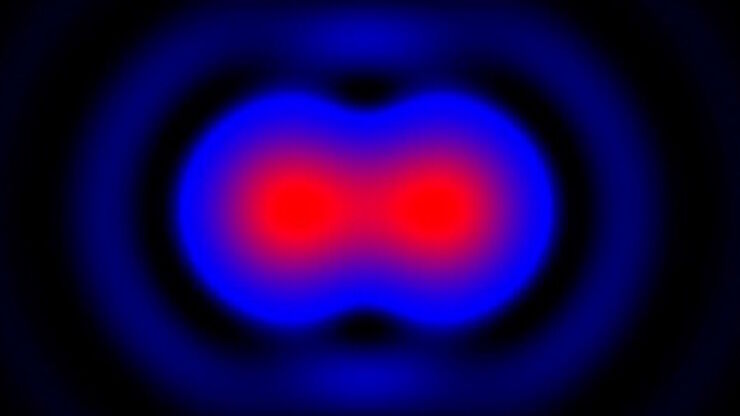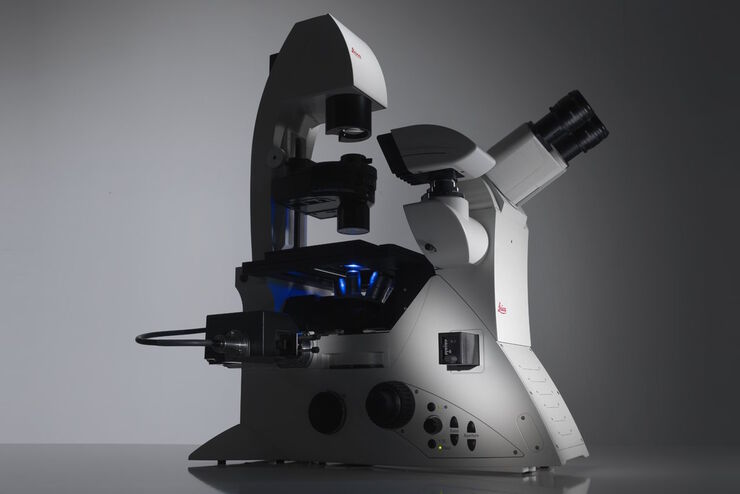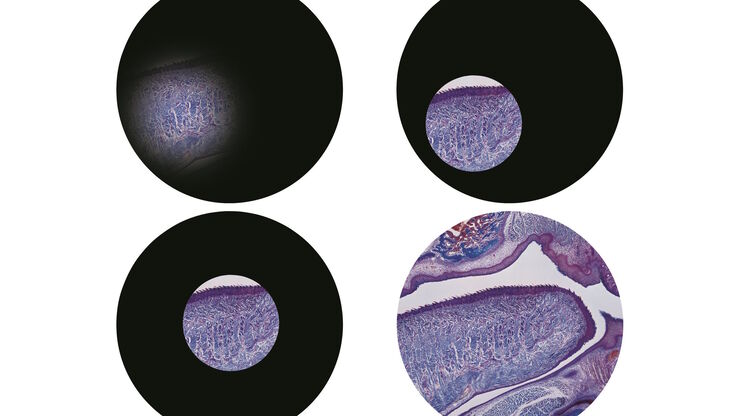Objective Classes
Objectives are categorized into performance classes on the basis of their transmission, chromatic correction, planarity, and others. From the point of view of the International Organization of Standardization (ISO), there are three groups of objective classes differing in quality of chromatic correction.
You have a need for sophisticated, highly specialized and unique lenses? You need small adjustments to existing lenses?
Overview Objective Classes
Leica achromats are powerful objectives for standard applications in the visual spectral range, offering field flatness (OFN) up to 25 mm. The absolute value of the focus differences between red wavelength and blue wavelength (2 colors) is ≤ 2x depth of field of the objective.
Leica semi-apochromats are objectives for applications in the visual spectral range with higher specifications, offering field flatness up to 25 mm. The absolute values of the focus differences for the red wavelength and the blue wavelength to green wavelength (3 colors) are ≤ 2.5x depth of field of the objective.
Leica apochromats are objectives for applications with highest specifications in the visual range and beyond, offering field flatness up to 25 mm. The absolute values of the focus differences for the red wavelength and the blue wavelength to green wavelength (3 colors) are ≤ 1.0 x depth of field of the objective.
Objective Class | Field Flatness (OFN) | Absolute Value(s) of Focus | Application |
Achromats | up to 25 mm | between red and blue wavelength (2 colors) is ≤ 2x depth of field | for standard applications in the visual spectral range |
Semi-Apochromats | up to 25 mm | for red wavelength and blue to green wavelength (3 colors) are ≤ 2.5x depth of field | for applications in the visual spectral range with higher specifications |
Apochromats | up to 25 mm | for red wavelength and blue to green wavelength (3 colors) are ≤ 1x depth of field | for applications with highest specifications in the visual range and beyond |

Leica Microsystems has aligned all three performance classes of its range of objectives to the needs of its customers and the specific requirements of a wide variety of applications – while offering a convincing price-performance ratio.
Leica Achromatic Lens
Leica achromats are powerful objectives for standard applications in the visual spectral range, offering field flatness (OFN) up to 25 mm. The absolute value of the focus differences between red wavelength and blue wavelength (2 colors) is ≤ 2x depth of field of the objective.
HI PLAN
HI PLAN objectives feature good chromatic correction at two wavelengths and flatness over the whole field of view. Even the edges of the image are sharp and require no refocusing. HI PLAN objectives are designed for visual fields up to 25 mm. Versions for phase contrast are available. Leica HI PLAN objectives offer good correction properties while being extremely reasonably priced.
N PLAN
The N PLAN objective class comprises further improved achromats with good field flatness up to 25 mm. N PLAN objectives are suitable for transmitted light and DIC, N PLAN PH for phase contrast. For incident light applications including differential interference contrast (DIC), N PLAN EPI objectives are available. The N PLAN EPI BD can also be used as a darkfield objective. The N PLAN EPI incident light objectives feature excellent image contrast and safe working distances.
FL PLAN
FL PLAN objectives are modern universal objectives with outstanding chromatic correction and field flatness (OFN) up to 25 mm. State-of-the-art coating techniques give FL PLAN objectives high transmission for fluorescence excitation. All contrasting methods are possible. FL PLAN objectives are optimized for fluorescence, PH and DIC.


Leica Semi-Apochromat
Leica semi-apochromats are objectives for applications in the visual spectral range with higher specifications, offering field flatness up to 25 mm. The absolute values of the focus differences for the red wavelength and the blue wavelength to green wavelength (3 colors) are ≤ 2.5x depth of field of the objective.
Leica Semi-Apochromats are labeled with FLUOTAR:
PL FLUOTAR (PL-FL)
PL Fluotars are powerful universal objectives with outstanding chromatic correction for at least three wavelengths which makes them suitable for fluorescence imaging.
Field planarity (PL) is computed for a 25 mm field of view. They are made of special glass to enable maximum transmission. This makes them powerful photon collectors in fluorescence microscopy.
Leica’s Fluotar portfolio features various application-optimized correction collars (CORR) to compensate for external influences such as temperature, coverslip thickness and immersion media.
Leica Apochromats
Leica apochromats are objectives for applications with highest specifications in the visual range and beyond, offering field flatness up to 25 mm. The absolute values of the focus differences for the red wavelength and the blue wavelength to green wavelength (3 colors) are ≤ 1.0 x depth of field of the objective.
We offer three apochromat classes:
PL APO
PL APO objectives – the class for professionals. They deliver imaging quality that cannot be achieved by conventional objectives. Plan Apochromats provide perfect axial and lateral color matching for applications requiring fast color change and the colocalization of structures. PL APO objectives are characterized by flawless image flatness up to a field number of 25. Top numerical apertures define a resolving power at the limits of what is physically possible.
PL IRAPO for Multiphoton Imaging and CARS
Whereas PL APO objectives are corrected in the visible wavelength range, with the PL IRAPO objectives a new set of specialized objectives is now available for improved multiphoton imaging (MP). The IR Apochromats are color corrected from at least 700 nm up to 1300 nm and highly transmissive in the visible and infrared wavelength ranges with > 85 % transmission from 470 – 1200 nm. Thus they are ideal for non-linear imaging like multicolor multiphoton imaging including excitation with OPO (optical parametric oscillator), and CARS (Coherent Anti-Stokes Raman Scattering).
PL APO CS and CS2 for Confocal Scanning
Within the class of apochromats, Leica offers PL APO lenses especially designed to match the highest specifications for confocal scanning (CS). The latest PL APO CS2 series was further improved over the previous CS series. The chromatic correction of the new Leica CS2 objectives is perfect over the whole field of view for precise colocalization of different fluorophores. In addition, numerical aperture and free working distance are pushed to new limits. The design of the Leica CS2 objectives goes hand in hand with the innovative UV optics of the Leica SP8, and the STELLARIS platform to give the most stable UV color correction. For aberration-free imaging in aqueous samples such as living cells, Leica Microsystems has developed a series of superior high-resolution water immersion objectives. For the best imaging results, these objectives require a correction collar to adapt the optics to varying coverglass thickness, changing temperature, and specimen inhomogeneity.
Manual adjustment of the correction collar requires time and experience, and is challenging when access to the objective is obstructed by additional equipment. The motorized correction of the Leica motCORRTM objectives simplifies adjustment of the correction collar and reduces training effort. Remote control of the Leica motCORRTM quickly adjusts the optics without disturbing the specimen.

Useful Sciencelab Stories
Immersion Objectives: Using Oil, Glycerol, or Water to Overcome some of the Limits of Resolution
To examine specimens at high magnifications using the microscope, there are a number of factors which need to be taken into consideration. These include resolution, numerical aperture (NA), the working distance of objectives and the refractive index of the medium through which the image is collected by the front lens of an objective.
Eyepieces, Objectives and Optical Aberrations
For most microscope applications, there are generally only two sets of optics which are adjusted by the user, namely, the objectives and the eyepieces. Of course, this is assuming that the microscope is already corrected for Koehler Illumination during which the condenser and diaphragms are adjusted.
Optical Microscopes – Some Basics
The optical microscope has been a standard tool in life science as well as material science for more than one and a half centuries now. To use this tool economically and effectively, it helps a lot to understand the basics of optics, especially of those essential components which are part of every microscope.
Special Objectives
For research involving highly specialized techniques or challenging samples, specially optimized objectives are often needed. Leica Microsystems offers a wide choice of special objectives for such applications.
Some examples:
- TIRF objectives with top numerical apertures
- Objectives with high transmission around 350 nm for laser microdissection
- Special objectives for patch-clamp applications on vital brain sections allowing measurements of individual ion channels using an inert dip-in objective
- Infrared-optimized multiphoton objectives for the visualization of biological structures deep in (living) tissue
- Water, glycerol and multi-immersion objectives with the correct refraction index for the sample medium for aberration-free imaging of thicker samples
- Automatic supply of water immersion during experiments with the Leica Water Immersion Micro Dispenser
- Objectives with improved color correction optimized for simultaneous use of 405 nm and visible excitation up to deep red excitation
- Objectives compatible with DLS TwinFlect mirror cap for Digital LightSheet (DLS) detection
- STED White Class dedicated objectives for nanoscopy: The superb chromatic correction of these specialized objective lenses ensures optimal overlay of excitation and STED PSF in z all over the visible spectral range

Related Articles
You have a need for sophisticated, highly specialized and unique lenses? You need small adjustments to existing lenses?


